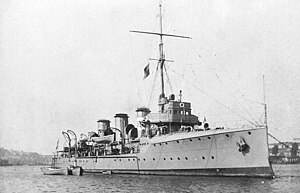 Patrol with her original 12-pounder guns
| |
| History | |
|---|---|
| Name | Patrol |
| Builder | Cammell Laird, Birkenhead |
| Laid down | October 1903 |
| Launched | 13 October 1904 |
| Commissioned | September 1905 |
| Decommissioned | 1919 |
| Fate | Sold for scrap, 21 April 1920 |
| General characteristics (as built) | |
| Class and type | Pathfinder-class scout cruiser |
| Displacement | 2,940 long tons (2,987 t) |
| Length | 370 ft (112.8 m) (p/p) |
| Beam | 38 ft 9 in (11.8 m) |
| Draught | 15 ft 2 in (4.6 m) (deep load) |
| Installed power |
|
| Propulsion | 2 Shafts, 2 triple-expansion steam engines |
| Speed | 25 knots (46 km/h; 29 mph) |
| Range | 3,400 nmi (6,300 km; 3,900 mi) at 10 knots (19 km/h; 12 mph) |
| Complement | 289 |
| Armament | |
| Armour |
|
HMS Patrol was one of two Pathfinder-class scout cruisers which served built for the Royal Navy in the first decade of the 20th century. The ship was in reserve for most of the first decade of her existence. After the beginning of the First World War in August 1914, she was assigned to coastal defence duties on the East Coast of England. Patrol was badly damaged during the German bombardment of Hartlepool in mid-December 1914 when she attempted to exit the harbour during the bombardment. After repairs were completed she remained on coast defence duties until she was transferred to the Irish Sea in 1918. The ship was paid off in 1919 and sold for scrap in 1920.